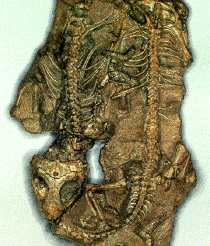Click on the buttons below to continue learning about the Anapsida.
For further exploration:




The clade Anapsida includes turtles and all their extinct relatives, which include millerettids, procolophonoids, pareiasaurs, as well as more poorly known taxa such as Acleistorhinus, lanthanosuchids, and nyctiphruretians. As you'll notice while you tour this section of the University of California Museum of Paleontology, the anapsids once consisted of many groups, many of which could be considered to have been quite successful until their extinction. Today, only one group of anapsids remains ( Chelonia -- the turtles), which truly could be called an evolutionary success story.
Extant (living) anapsids have a nearly worldwide distribution; they inhabit all the continents except Antarctica. The geographic origin of Anapsida has not yet been determined because the fossil record of Paleozoic tetrapods is too poor and localized, but the oldest known anapsid comes from the Lower Permian of North America. By the Upper Permian, anapsids are also known from Europe, Asia, and Africa.
Click on the buttons below to continue learning about the Anapsida.


